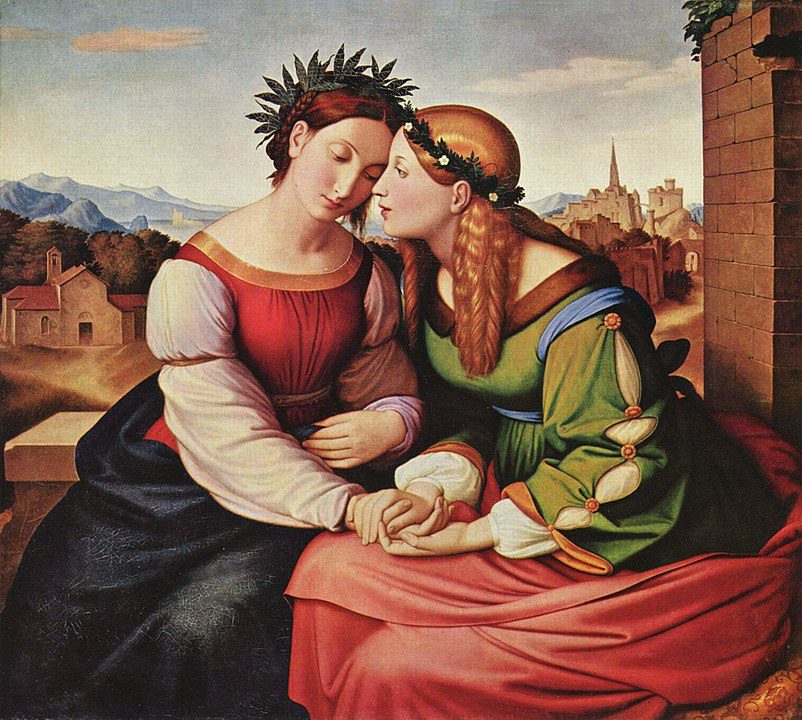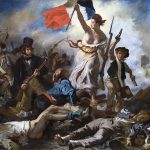
The Nazarene movement was an artistic and spiritual revival that emerged in the early 19th century, aiming to restore the purity, piety, and craftsmanship of medieval and early Renaissance art. Reacting against the cold rationalism of Neoclassicism (1750s–1830s) and the emotional excess of Romanticism (1800–1850), the Nazarene artists sought to infuse religious art with sincerity, morality, and historical authenticity. They turned to medieval Christian themes, biblical narratives, and the styles of early Renaissance masters such as Fra Angelico (c. 1395–1455), Albrecht Dürer (1471–1528), and Raphael (1483–1520).
The movement began in Vienna in 1809, when a group of young German and Austrian painters, disillusioned with academic art, formed the Brotherhood of St. Luke (Lukasbund). Their goal was to abandon the artificiality of contemporary art and return to the spirituality and craftsmanship of the Middle Ages. In 1810, several members moved to Rome, settling in the abandoned San Isidoro monastery, where they lived as a quasi-monastic community dedicated to their artistic and religious ideals.
The Nazarene artists gained recognition for their large-scale frescoes, religious altarpieces, and historical paintings, which combined medieval Gothic elements with early Renaissance clarity and composition. Their work influenced the Pre-Raphaelite Brotherhood (founded in 1848 in England) and contributed to the revival of Christian and historical themes in 19th-century European art.
This article explores the origins, key themes, major artists, and long-term influence of the Nazarene movement. By the end, readers will understand why this spiritual and artistic revival remains a fascinating chapter in the history of religious and historical painting.
The Historical Context Behind the Nazarene Movement
The Nazarene movement arose in reaction to the dominant art styles of the late 18th and early 19th centuries, particularly Neoclassicism and the emerging Romantic movement. Neoclassical art, inspired by the ancient Greeks and Romans, was admired for its idealized forms, balance, and rationalism. However, many young artists found it cold, impersonal, and disconnected from spirituality.
At the same time, Romanticism (c. 1800–1850) was gaining popularity, emphasizing emotion, nature, and dramatic storytelling. While some aspects of Romanticism resonated with the Nazarenes, they rejected its theatricality, excessive individualism, and secular themes. Instead, they sought to restore religious devotion in art, looking back to the Middle Ages and early Renaissance for inspiration.
A major influence on the movement was the growing interest in medieval Christianity and historical revivals. The early 19th century saw a resurgence of Gothic Revival architecture, along with a renewed admiration for the art and faith of the medieval period. Writers such as Johann Wolfgang von Goethe (1749–1832) and Friedrich Schlegel (1772–1829) praised the mysticism and sincerity of medieval religious art, reinforcing the Nazarene belief that Christian spirituality should be central to artistic expression.
The Nazarene artists believed that art should not be about academic perfection but about moral and religious truth. By embracing biblical themes, historical Christian subjects, and the techniques of Renaissance masters, they aimed to create an art form that was spiritually uplifting and culturally restorative.
Key Themes and Characteristics of Nazarene Art
Nazarene art was characterized by devout religious themes, historical accuracy, and a rejection of contemporary academic traditions. Unlike the grandeur of Baroque art or the idealized perfection of Neoclassicism, the Nazarenes sought to restore art as a form of Christian devotion, humility, and storytelling.
One of the movement’s most defining features was its use of medieval and early Renaissance styles. The Nazarenes avoided classical Greco-Roman influence, instead drawing inspiration from Gothic and early Renaissance painters. Their works often featured flat perspectives, delicate outlines, bright colors, and elongated figures, reminiscent of Fra Angelico, Perugino (1446–1523), and Albrecht Dürer.
Religious subject matter dominated Nazarene art, particularly scenes from the Bible, Christian history, and saints’ lives. Unlike the dramatic, theatrical compositions of Baroque painting, Nazarene works focused on spiritual purity, reverence, and narrative clarity. *Johann Friedrich Overbeck’s Christ’s Entry into Jerusalem (1824–1829) exemplifies this approach, depicting a solemn, reverent Christ surrounded by calm, devotional figures.
Another key characteristic of Nazarene art was its emphasis on communal artistic projects, particularly fresco painting. Inspired by Italian Renaissance masters, the Nazarenes revived the lost tradition of large-scale religious frescoes, working together to create murals in churches and palaces. Their most famous fresco cycles were created in Rome at the Casa Bartholdy (1816–1817) and the Casino Massimo (1817–1829), depicting biblical and medieval Christian themes.
The Great Masters of the Nazarene Movement
The Nazarene movement was led by a small but dedicated group of German and Austrian painters, each of whom played a vital role in shaping its aesthetic and spiritual vision.
Johann Friedrich Overbeck (1789–1869) – The Spiritual Leader
- The most influential Nazarene artist, Overbeck was deeply committed to religious revival in art.
- Converted to Catholicism in 1813, believing art should serve spiritual rather than secular purposes.
- Major works: Christ’s Entry into Jerusalem (1824–1829) – a clear, solemn religious narrative in early Renaissance style.
Franz Pforr (1788–1812) – The Visionary of Medievalism
- Co-founder of the Brotherhood of St. Luke, dedicated to reviving medieval religious art.
- Died young but left a strong legacy in spiritualized, highly detailed historical paintings.
- Major work: Shulamit and Mary (1811) – a symbolic comparison between the Virgin Mary and medieval religious ideals.
Peter von Cornelius (1783–1867) – The Monumental Fresco Painter
- Helped expand Nazarene ideals to public fresco projects, creating large-scale biblical scenes.
- Worked on major mural commissions in Rome and Germany, influencing church decoration for generations.
- Major work: The Last Judgment (1836–1839) – a highly detailed, medieval-style fresco in Ludwig I’s Glyptothek in Munich.
Julius Schnorr von Carolsfeld (1794–1872) – The Master of Biblical Illustration
- Specialized in detailed, dramatic biblical illustrations, blending Renaissance and medieval traditions.
- His Biblical Pictures (1852–1860) became one of the most famous 19th-century illustrated Bibles.
- Major work: Joseph and His Brothers (1816–1817) – a classic Nazarene biblical composition with narrative clarity.
The Decline and Legacy of the Nazarene Movement
By the mid-19th century, the Nazarene movement began to decline as Realism (1840s–1890s) and later Impressionism (1860s–1890s) took hold. However, its influence remained strong in:
- The Pre-Raphaelite Brotherhood (founded 1848, Britain), which continued the Nazarene focus on spirituality, medieval themes, and early Renaissance techniques.
- Gothic Revival architecture, which incorporated Nazarene ideals into church frescoes, stained glass, and religious imagery.
- Religious art commissions throughout Germany, Italy, and England, which maintained Nazarene-inspired biblical storytelling.
The Decline and Legacy of the Nazarene Movement
By the mid-19th century, the Nazarene movement began to fade from prominence, as the art world shifted toward new styles and concerns. While the movement had been a major force in the early 1800s, by the 1840s and 1850s, Realism and later Impressionism overtook the Nazarene ideals of spiritual purity and medieval revivalism.
One of the main reasons for the movement’s decline was the changing role of religious art in society. The rise of secularism, industrialization, and scientific progress made the Nazarene focus on medieval spirituality seem outdated to many artists and patrons. In contrast, Realist painters like Gustave Courbet (1819–1877) rejected the idealized biblical and historical themes of the Nazarenes in favor of depicting everyday life with unembellished accuracy.
Another factor in the movement’s decline was the loss of its original members. Franz Pforr died young in 1812, and by the 1860s, figures like Overbeck and Cornelius had moved away from their radical beginnings, accepting more mainstream commissions. As artistic tastes evolved, the Nazarene emphasis on flat, linear compositions and medieval-style figures appeared increasingly outdated compared to the more dynamic and experimental styles emerging in France, Germany, and England.
However, the Nazarene influence did not disappear completely. Their focus on spirituality, early Renaissance techniques, and historical themes left a lasting mark on several later movements. Their legacy can be seen in the Pre-Raphaelite Brotherhood (founded in England in 1848), which shared their admiration for medieval subjects, precise detail, and religious sincerity. Additionally, the Nazarene commitment to church decoration and large-scale fresco painting contributed to the Gothic Revival movement, which shaped religious architecture and interior design throughout the 19th century.
The Lasting Legacy of the Nazarene Movement
Although the Nazarene movement did not dominate European art beyond the mid-19th century, its influence remained strong in religious art, historical painting, and medieval revival movements. Several key developments demonstrate how the Nazarenes shaped later artistic traditions:
- The Pre-Raphaelite Brotherhood (founded 1848) – British artists like Dante Gabriel Rossetti (1828–1882), John Everett Millais (1829–1896), and William Holman Hunt (1827–1910) were deeply influenced by the Nazarene ideals of spirituality, medieval aesthetics, and early Renaissance purity. Their works continued the quest for moral and religious depth in art while adopting more vivid color and naturalistic detail.
- 19th-Century Church Decoration and the Gothic Revival – The Nazarene emphasis on large-scale biblical frescoes and medieval religious themes contributed to the rise of Gothic Revival architecture and church decoration across Europe. Many churches in Germany, England, and Italy incorporated Nazarene-inspired murals, stained glass, and altarpieces.
- Historical Painting and the National Romantic Movement – The Nazarenes’ devotion to historical accuracy, religious storytelling, and national identity influenced German and Austrian historical painters of the late 19th century. Artists such as Moritz von Schwind (1804–1871) incorporated Nazarene-inspired medievalism into their depictions of Germanic folklore and legend.
- Christian Art in the 19th and 20th Centuries – Religious painters and illustrators working in Catholic and Protestant traditions throughout the 19th and early 20th centuries continued to draw upon Nazarene compositions, biblical themes, and devotional imagery for inspiration. Their influence extended even into modern religious art and iconography.
Today, works by the Nazarene artists can be found in major European museums, including the Alte Nationalgalerie in Berlin, the Städel Museum in Frankfurt, and the Vatican Museums in Rome. Their fresco cycles in Rome’s Casino Massimo and Casa Bartholdy remain important historical examples of their artistic vision. Though often overshadowed by Romanticism and Realism, the Nazarene movement played a crucial role in keeping medieval Christian art and early Renaissance techniques alive in the 19th century.
Final Thoughts
The Nazarene movement was more than just an artistic style—it was a spiritual and cultural revival that sought to restore religious devotion in art. Though it eventually faded, its dedication to medieval Christian themes and early Renaissance techniques left a lasting mark on 19th-century European art. Today, the Nazarenes are recognized as pioneers of religious and historical revivalism, inspiring later movements that sought to reconnect art with faith, storytelling, and national identity.
Key Takeaways
- The Nazarene movement (1809–1850s) sought to revive medieval spirituality and early Renaissance techniques in response to Neoclassicism and Romanticism.
- Founded in Vienna in 1809 by the Brotherhood of St. Luke, the movement later relocated to Rome in 1810, where it flourished.
- Key artists included Johann Friedrich Overbeck, Franz Pforr, Peter von Cornelius, and Julius Schnorr von Carolsfeld.
- Their works emphasized biblical themes, medieval aesthetics, and fresco painting, rejecting the academic and classical traditions of their time.
- The movement declined by the mid-19th century but influenced the Pre-Raphaelite Brotherhood, Gothic Revival architecture, and religious art.
FAQs
- What was the main goal of the Nazarene movement?
– To restore the spiritual purity and moral sincerity of medieval Christian art, rejecting Neoclassicism and academic traditions. - Why did the Nazarene artists settle in Rome?
– They believed Rome was the spiritual heart of Christian art and sought inspiration from Renaissance fresco painting and religious traditions. - Which artists were part of the Nazarene movement?
– Johann Friedrich Overbeck, Franz Pforr, Peter von Cornelius, and Julius Schnorr von Carolsfeld were among its most influential members. - How did the Nazarene movement influence later art?
– It inspired the Pre-Raphaelite Brotherhood, 19th-century religious art, and the Gothic Revival in architecture. - Where can Nazarene paintings and frescoes be seen today?
– In museums like the Alte Nationalgalerie (Berlin), the Städel Museum (Frankfurt), and the Vatican Museums, as well as in Rome’s Casino Massimo and Casa Bartholdy.




